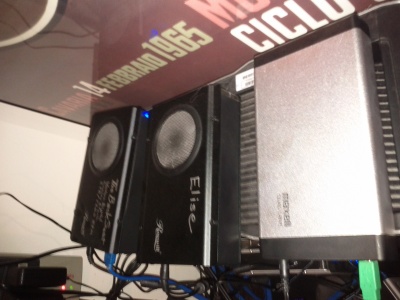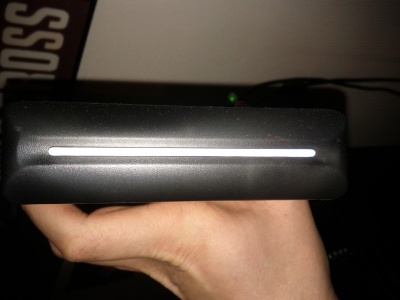I don’t usually buy external hard drives unless they are very specialized. I’ve been eyeing the Drobo Pro for a few years now, because it comes with special software that enables you to RAID drives of different speeds and sizes without loss of space. I like the Maxell iVDR because it is hardened to go in the field and shoot with an HDV camera. I’ve even started looking at these new hard drives that come in a shell that is supposed to work like an airplane’s black box, protecting the data within from impact, fire and water. So, what do I make of Maxell’s offering, the Maxdata Quad? Maxell sent me a free one to review, and I have some thoughts.
Well, it’s a hard drive. It plugs in with USB 2, Firewire 400 & 800 and eSATA 3G. It runs at 7200 RPM and it’s a hefty 2TB. So, it’s big, it’s fast enough for backing things up (but not really as a media drive, unless you’re using a laptop and not running things in full HD) and it has a lot of handy plugs. It needs an external AC adapter, but okay, so far, so good.
I used it a couple of different ways. First, when it arrived, it was formatted in FAT32, which I imagine is so Maxell could slap a “PC and Mac compatible” sticker on the box. FAT32, for those of you who don’t know, is an archaic format developed by Microsoft in the good old days of XP to be Mac and PC compatible. It’s fine, unless you need to make files bigger than 2GB. Then it’s useless. FAT32 literally can’t handle files over 2GB so if you try putting your video outputs there, it won’t let you.

Maxdata Quad (at right) beside two home made drives. The middle drive is 300GB at 10K RPM and the leftmost drive is 2TB at 7200 RPM
So, as a media drive, this thing is useless. I needed to copy some media onto it and it just couldn’t handle it. I had to reformat it, which isn’t a big deal, but if I didn’t know what I was doing, I’d be in a pickle. I made this thing NTFS, though since I run Macdrive software on my HP Z800, I could have made it a Mac formatted disk just as easily.
As an NTFS disk, I plugged it in first as Firewire, which worked okay although the computer lost sight of it a couple times, then as USB, which hasn’t had any issues. Honestly, I wish it were USB 3 because I have the card and it’s just as good as Firewire, which is not that useful anymore given the advent of thunderbolt. Of course, neither of these plugs mean much with an eSATA port on the box. With a spare eSATA cable from my RAID controller I plugged it in and whoosh! Nice and fast. As fast as an internal drive of the same speed. I’ve been transcoding my work library from Quicktime to MP4 so I loaded the Quicktimes on the Maxell and made the transfers to my internal storage. So far the only problem with any of this is that quicktime crashes if I tell it to convert too many files at once.
So, the drive is good. Thumbs up. The only question I ever have about an external drive is this: when the bus in the box dies, and it will one day, can I extract the drive and put it in another enclosure? Lots of external drives fall down here. If the bus dies and you can’t get the drive out and into another box, then you have a working hard drive but no workable way to get the data off it. It’s like a Dalek in one of those Dalek pods with the batteries flat.

A Dalek, inside its Dalek exoskeleton thing. What happens to the Dalek when its exoskeleton runs out of juice? How will it get out?
Sadly, without having to pay Maxell for the privilege of ripping apart its drive with a screwdriver, I can’t tell for sure if this is an issue here.
The drive goes for $326 (retail) according to Maxell. I’m sure if it’s made as well as the other Maxell products I’ve used it’s fine. Still, $326 is a little steep unless you’ve got your back up against the wall. For $129 at Newegg, you could get a comperable 2TB internal drive (I won’t say which one) and put it in a $30 box with all the same plugs as the Maxell (minus the Firewire) and of course, an internal drive in an external box can be unplugged from the box and put into the computer or another box later. So the choice of buying a drive like this is a personal one. If you don’t feel comfortable taking things apart, or you just can’t be bothered, it’s probably worth the extra money to buy this drive. For the advanced user, it’s main strength is the multiple ports on the back. That being the case, I’d be tempted to put in a 10,000 RPM drive and use it for full HD media. Of course, I don’t know if I can do that, because I’d have to pay Maxell for the drive they sent me in order to open the box.
As for the Mac and PC compatibility issues, I think it’s a wash. There is no point to keeping anything FAT32 these days. Just reformat to NTFS or whatever you want and leave it at that. A lot of the need to put things on a drive and go between Mac and PC is media and media files are too big to go on this thing if it’s FAT32, despite its overall capacity.
Drive makers need to understand they are competing with cloud storage, so their drives need to work for the kinds of things people send around better than the cloud does. Cloud storage has some legal issues coming down the pike (see below) it takes more time than loading things onto a drive, good cloud storage is expensive and some cloud storage isn’t that secure.
In light of these issues, portable hard drives can make a case for themselves, provided that they take advantae of what makes them special. I’ve already mentioned the “black box” hard drives that are damage resistant. Then there is network operable stuff like Drobo. If you aren’t either of those ultra-specialized drive makers, you have some challenges, but here’s the solution:
Portable drives need to be
a.) fast – at least 7200 RPM
b.) flexible – you should be able to take the drive out of the box if you want and there should be a lot of ports on it, like this one.
c.) in an ideal world, the drive should come with a software package that adds the value of making it compatible with multiple platforms without needing some special format or software installed on the drive itself.
I know someone who uses Dropbox to send things between two computers in his own house. Crazy. Cloud storage runs into some of its unique problems. If Maxell bundled software that enabled Mac to PC and PC to Mac disk reading, then the drive could be formatted in some sane format and there would be a lot of added value to the product. I’m talking about a disc with software, not something loaded onto the drive. Drives should be malleable. I don’t like being told it has to be formatted one way or another. They could even keep the PC and Mac compatible sticker on the box and mean it. As it stands, for my purposes, it’s an expensive backup drive. If you’re not a tinkerer though and you need a massive bucket of storage (and you don’t have files bigger than 2GB) go for it.



